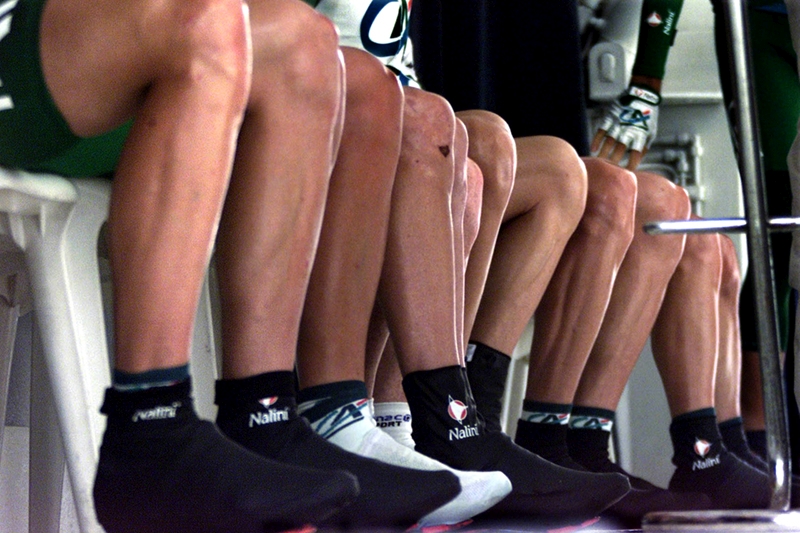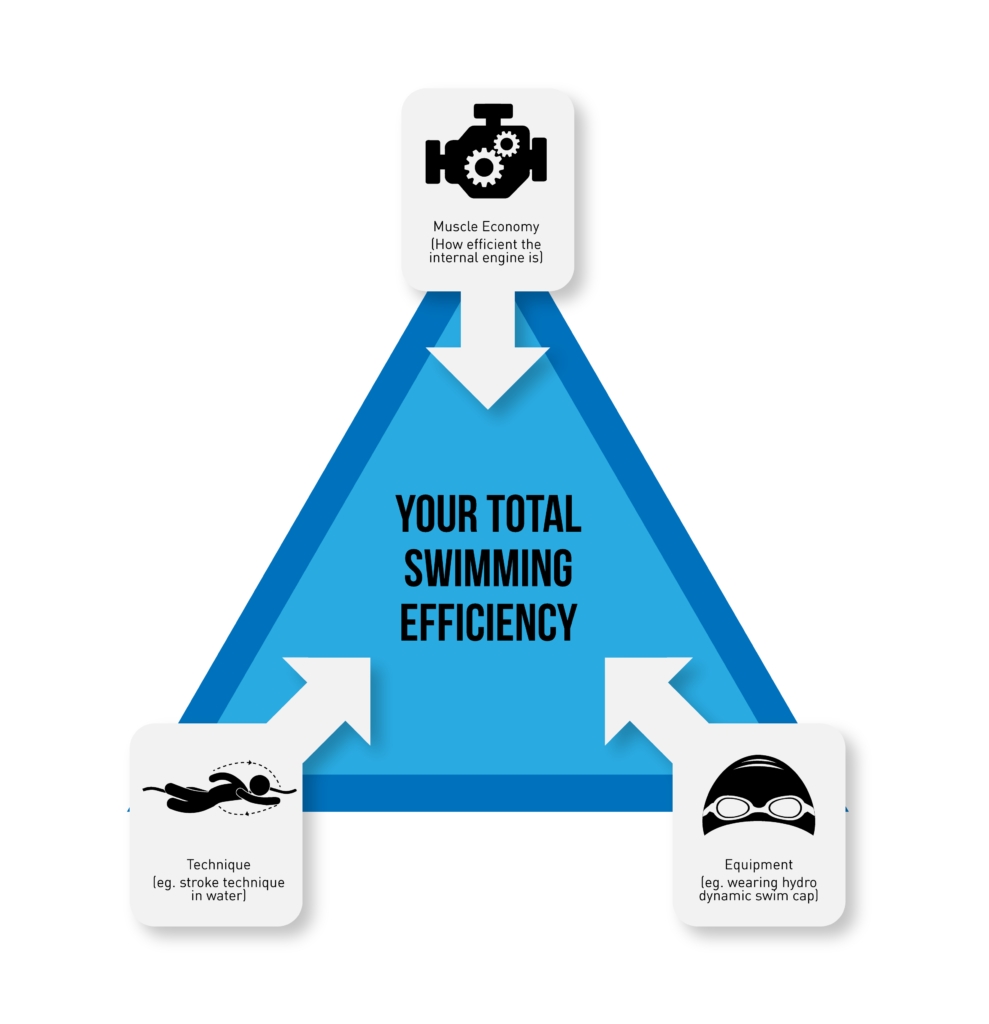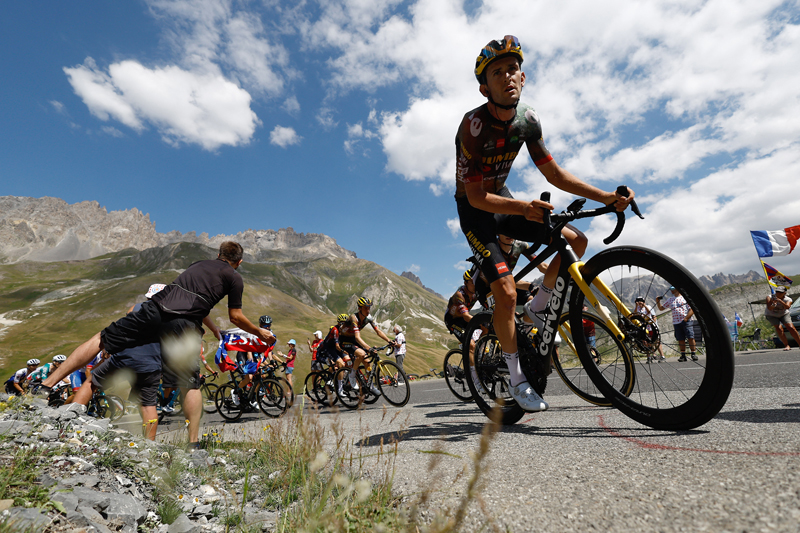You are viewing 1 of your 1 free articles. For unlimited access take a risk-free trial
Efficiency matters
Andrew Hamilton looks at why muscular efficiency matters for endurance athletes and provides practical tips to boost your own efficiency

Andrew Hamilton looks at why muscular efficiency matters for endurance athletes and provides practical tips to boost your own efficiency
Back in the 19th century, British Prime Minister Benjamin Disraeli achieved lasting fame by initiating a wide range of legislation to improve educational opportunities and the life of working people. Disraeli was also a colourful
character renowned for his satire; for example, it was he who coined the phrase “Lies, damned lies and statistics.” But he also had more serious things to say, one of them being that “there can only be economy when there is efficiency.” He was talking about economics of course, but this is a phrase that can be equally applied to endurance performance.
Efficiency and economy
Before we look at the recent thinking on efficiency and how to apply it in training, we first need to define what we mean by efficiency and muscular economy. In the context of sport, these two terms have a very similar meaning, but they’re not quite the same.
Figure 1: Relationship between muscle economy and efficiency

‘Efficiency’ is a broad-brush term, which refers to how much energy is expended while moving at a given pace – eg through the water when swimming or across the ground when running. Greater efficiency means that less energy is required to sustain a given pace. In the case of a cyclist for example, greater efficiency can be achieved by adopting a more ‘aero’ position so that less energy is wasted overcoming wind resistance. Similarly, swimmers who improve their stroke technique will become more efficient, wasting less energy overcoming hydrostatic resistance. This in turn means more energy is available for propulsion through the water. Runners meanwhile can benefit from energy return shoes that are more mechanically efficient.
The above examples show how efficiency is affected by external factors. But there’s another component to efficiency, and that’s to do with how much energy in used internally by your muscles. Muscles that work very efficiently are able to generate more propulsive force while requiring less energy (and therefore less oxygen). This internal type of efficiency is referred to as ‘muscle economy’. Economy refers to how efficient the muscles are (in terms of oxygen usage) at producing force during sub-maximal exercise (ie not flat out). The better the economy of your muscles during exercise, the less oxygen you need to use to propel yourself along at a given speed.
Note however that economy is not the same as technical efficiency. You can swim faster for the same effort by improving your technical efficiency in the water even though your actual muscles aren’t contracting more efficiently. Muscle economy on the other hand is related to the chemical and biomechanical efficiency of contracting muscle fibres. In other words, your muscle economy while running, swimming, cycling etc is but one component that determines your overall efficiency (see figure 1). Due to space and time constraints, we can’t discuss all aspects of efficiency in depth, so from here on, it’s improving muscle economy that we’ll be considering.
Good news on the economy
You might assume that only the external aspects of efficiency such as technique and aerodynamics can be improved. However, the good news is that cycling, running or swimming economy is not fixed. By training in a specific way, you can increase your muscle economy. So for example, suppose you improved your cycling economy by 3%. This means that for the same level of oxygen consumption, perceived effort and cycling speed, you would now require 3% less oxygen, which also means less fatigue, particularly over longer events – akin to switching from standard to fancy aero carbon wheels, but far cheaper!
This is important for older athletes; while it’s possible over time to improve your technique and equipment efficiency, muscle economy tends to decline with advancing years. Just last year, a study on young (average age 28) and older (average age 60) triathletes with similar number of years of training experience investigated the triathletes’ running and cycling economy during sub-maximal exerciseEuropean Journal of Applied Physiology 2016. Volume 116 (1) 195-201. Although the young triathletes had higher overall levels of aerobic power than the masters triathletes (aerobic power tends to decline with age), at lower levels of exertion, the older triathletes’ cycling and running economy was around 11 % lower than the younger triathletes – indicating their muscles were also working less efficiently.
If muscle economy measures how efficiently muscles work at sub-maximal work rates (ie not flat out), why is it important for maximising race performance I hear you ask? Well, studies show unequivocally that elite athletes have much higher levels of muscle economy than their amateur or recreational counterparts. In other words, muscle economy and high levels of endurance go hand in hand.
One study of collegiate cross-country team members discovered that just two factors – maximum aerobic capacity (VO2max) and running economy - could account for 92% of the variance in performance during an 8000m raceJ Sports Med Phys Fitness. 1991 Sep; 31(3):345-50. Also, running economy, like VO2max, has been used to estimate marathon pace in elite runnersJ Physiol. 2008 Jan 1; 586(1):35-44.
In another study, researchers compared elite Eritrean runners with elite Spanish runnersAppl Physiol Nutr Metab. 2006 Oct;31(5):530-40. Although both groups had very similar maximum aerobic capacities, the researchers were mystified as to why the performances of the Eritrean runners were consistently better than those of the Spaniards. Testing on both groups revealed that the key physiological difference was the exceptional running economy of the African runners; at 21kmh (13.0mph), the Eritreans needed to consume just 65.9mls of oxygen per kilo per kilometre - compared with 74.8mls of oxygen for the Spanish runners (see figure 2 overleaf)!
But you don’t have to be an elite athlete to experience the benefits of improved muscle economy. Even an averagely fit recreational sportive rider can reap the benefits of improved muscle economy. For example, a 4% gain in economy would mean that over a 100-mile event he/she would cover the distance around quarter of an hour faster for exactly the same effort!
Figure 2: Oxygen consumption per kilo per kilometre at 21kmh

The Eritrean runners’ superior running economy meant they needed 13.5% less oxygen per kilo of body weight to maintain a marathon pace. This explained much of their performance advantage over their Spanish counterparts.
Improving economy
As a rule of thumb, your muscle economy will improve with increasing levels of fitness. But are there any techniques you can use to further boost gains in economy? Recent research tells us that the answer is ‘yes’, and that certain training and nutritional approaches can significantly boost economy in a relatively short space of time.
One of the most effective ways of boosting your muscle economy is to strength train – using heavy weights! While this approach seems entirely counterintuitive, there’s a growing body of evidence that it really can help increase muscle economy and aid endurance performance.
Although it largely slipped under the radar, one of the earliest studies to show that heavy strength training can improve muscle economy was conducted on X-country skiersScand J Med Sci Sports. 2002 Oct;12(5):288-95. Nineteen highly trained cross-country skiers were split into two groups; one group simply carried on doing skiing training while the other performed strength training three times a week for eight weeks, using a cable pulley simulating the movements in double poling in cross-country skiing. Each session consisted of 3 sets of 6 reps at 85% of 1-rep maximum (heavy). Subsequent testing on a ski ergometer at full pelt showed that the strength-trained skiers improved their economy by a huge 26%!
A few years later, researchers studied the effects of explosive strength training and very high intensity cycling sprints on endurance and sprint performanceJ Strength Cond Res. 2005 Nov;19(4):826-30. Eighteen road cyclists were assigned to an experimental or control group for 5 weeks of training. The experimental group replaced part of their usual cycling training with twelve 30-minute sessions consisting of three sets of explosive single-leg jumps, alternating with three sets of high-resistance cycling sprints; the control group meanwhile simply maintained their normal cycling training. The results showed that compared to the control group, the riders in the strength/sprinting group showed dramatic increases in power and endurance capacity (see table 1).
Table 1 Performance changes produced by 5 weeks of strengthsprint training 2022 10 04
| 1km power | Increased by 8.7% |
| 4km power | Increased by 8.1% |
| Peak power | Increased by 6.8% |
| Power at lactate threshold | Increased by 3.7% |
| Cycling economy | Increased by 3.0% (ie oxygen cost at given workload was 3.0% less) |
The results above speak for themselves but what particularly surprised the researchers was that the strength/sprint training improved cycling economy – an aspect of performance that most scientists had previously thought would only respond to endurance training.
The positive effects of heavy strength training on cycling economy were confirmed by other studies. For example, a study on sixteen competitive road cyclists showed that compared to no strength training, performing half-squats 3 times per week for eight weeks, as a supplement to normal riding training increased cycling economy while cycling at 70% VO2max (moderate intensity) by 4.8%J Strength Cond Res. 2010 Aug;24(8):2157-65.It also increased the time to exhaustion at maximal aerobic power by 17.2% despite there being no changes in maximum aerobic capacity or body weight of the strength-trained riders! The researchers concluded: “Based on these results, we advise cyclists to include maximal strength training in their training programs.”
There’s also evidence that running economy can be improved by strength training. Runners who performed half-squats (4 sets of 4RM), three times per week for eight weeks, as a supplement to their normal endurance training increased their running economy by a whopping 5% compared to those who simply maintained their running trainingMed Sci Sports Exerc. 2008 Jun;40(6):1087-92. Likewise, Australian scientists found that in highly trained runners, plyometric strength training improved running economy by 4.1% at a treadmill speed of 18kmhJ Strength Cond Res. 2006 Nov;20(4):947-54.
Cadence and cycling economy
Although not a method of increasing economy per se, it’s worth mentioning that cyclists can favourably influence their muscle economy during sub-maximal riding simply by altering cadence. That’s because studies have shown that cycling economy is significantly affected by your pedalling speed (cadence). In one study, thirty trained cyclists completed 6-minute trials at a hard but sustainable pace on the road while their power outputs and oxygen consumption was measuredInt J Sports Physiol Perform. 2015 Oct;10(7):830-4. When cadence was increased from 60rpm to 90rpm, the efficiency of the cyclists dropped by around 2.5% (indicating they were working significantly harder to sustain the same pace), suggesting that ‘spinning’ a lower gear is NOT the most economic way to pedal when you’re cycling at a moderately hard pace.
Likewise, another study investigated competitive male road cyclists who cycled for 180 minutes at either 80 or 100rpm with varying intensities of power outputs, which corresponded to 50% (easy intensity), 65% (easy to moderate intensity) and 80% (fairly hard intensity) of the cyclists’ maximum aerobic capacity (VO2max)J Sports Sci Med. 2014 Jan 20;13(1):114-9. It found that muscle economy efficiency was typically around 1.5% lower at 100rpm compared to 80rpm, and concluded ‘the use of a high cadence during low to moderate workloads is not economical and may compromise performance during prolonged cycling’ – see figure 3.
“spinning a lower gear is NOT the most economic way to pedal when you’re cycling at a moderately hard pace”
Figure 3: Cadence and cycling economy

At both 65% VO2max (easy-moderate) and 80% VO2max (hard), gross efficiency – which in this case directly equates to muscle economy – was improved at 80rpm compared to 100rpm.
Stretching or root veg?
The evidence that heavy-strength training boosts economy is certainly persuasive. But are there any other effective strategies? Because muscle economy is a function of the biomechanical efficiency of contracting muscles, some researchers have suggested that reducing tension in muscles with preexercise stretching could improve economy. However, there’s little evidence to support this notion. When trained runners performed ten minutes of treadmill running at 70% of VO2max after prolonged static stretching (consisting of stretching each leg unilaterally with each of eight different exercises, all stretches held for 40 seconds) there was no absolutely improvement in running economy compared to no stretchingJ Sports Sci. 2008 Dec;26(14):1489-95.
However, one alternative strategy that has been proven to boost economy is a nutritional manipulation – to consume nitrate-rich foods such as beetroot, beetroot juice and other nitrate-rich vegetables before exercise (see table 3). That’s because once in the body, nitrate can be converted to an important signalling molecule called nitric oxide.
Nitric oxide (NO) is an incredibly important signalling molecule in the body, and vitally important for the health of the cardiovascular system. A key function of NO is to help blood vessels widen and relax (known as vasodilation), which promotes increased blood flow and helps reduce blood pressure. This in turn can reduce the risk of stroke and heart disease. Importantly, we now know that eating foods rich in nitrate (eg beetroot, spinach etc – see table 3) can boost natural NO production in the body, resulting in better blood flow.
Table 3 The six nitrate richest foods 2022 10 04
| Food | Average nitrate content (milligrams per kilo of food) | Typical range of nitrate content (milligrams per kilo) |
|---|---|---|
Rocket  |
2600 | 2600* |
Spinach  |
2140 | 970-4260 |
Celery  |
1890 | 970-2780 |
Radish  |
1870 | 1060-2600 |
Beetroot  |
1460 | 640-1800 |
Lettuce  |
1390 | 1040-1860 |
| Average nitrate shows the typical nitrate content. The range is included to show that actual nitrate content will depend on soil type, growing conditions, harvesting etc. *No range shown for rocket as data only available for 1 sample. | #colspan# | #colspan# |
Nitrate and endurance
The benefits of dietary nitrate aren’t limited to health however because recent research has shown that consuming nitrate before exercise can significantly boost exercise performance. Back in 2007, Swedish scientists discovered that giving 500mgs of nitrate as a supplement (an amount that can be easily consumed when consuming a high-vegetable diet) enabled cyclists to maintain the same work output while using less oxygen – ie it improved muscle economyActa Physiol (Oxf). 2007; 191(1):59-66. This effect has also been confirmed in other studies.
In the meantime, British scientists found that consuming beetroot juice (very rich in naturally occurring nitrate) before exercise improved muscle economy and extended the time-to-exhaustion during intense cycling by a massive 16%J Appl Physiol. 2009 Oct;107(4):1144-55, and a study carried out by Dutch scientists found similar benefits of beetroot juice supplementation during 10km cycling time-trial performanceInt J Sport Nutr Exerc Metab. 2012 Feb;22(1):64-71. Other studies on nitrate consumption before exercise have demonstrated performance benefits for walking and runningJ Appl Physiol 2011; 110: 591–600 and for swimmersNutrients. 2014 Jan 29;6(2):605-15.
Putting it into action
We’ll split this section in two: How to implement strength training and how to boost your nitrate intake.
Strength training
How should I add strength training into my endurance routine?
- The evidence suggests that it should not be added in a way that pushes you into an exhausted or overtrained state. Or to put it another way, if your cycling/running/swimming/rowing etc routine is pushing you to the limit already, rather than add a couple of strength sessions a week, you need to replace or shorten a couple of your endurance-training sessions with strength sessions to ensure that your overall workload isn’t increased.
- For most endurance athletes, just one session a week will suffice, but this could be increased to two per week during the off/winter season.
- Adjust your routine so that the day after strength training is reserved for low-intensity endurance work, or rest.
What kind of sessions should I perform?
- Runners and cyclists should concentrate on leg strength, preferably using half-squats, as per many of the studies (see figure 3). For beginners, or for those with a history of back injury, seated leg presses may be preferable.
- Swimmers (and triathletes) should focus on strengthening the back muscles, especially latissimus dorsi, which is the main propulsive muscle in the water. One of the best exercises is the front-grip pull up using a slightly wider than shoulder width grip (figure 4 overleaf). This can be complemented by dips from bars (figure 5 overleaf). Both exercises can be weighted if need be (to limit reps to 6).
- You should use high weight and low reps. Set the weight so that you can only achieve around 6 reps. However, you MUST maintain good form throughout.
- Two to three hard-effort sets per body part is ample. Allow 2-3 minutes rest between sets. Do not spend more than 30 minutes in the gym – a short intense session is far more effective than hours of moderate-intensity reps!
- Those new to resistance training or unfamiliar with the exercises described should start only gently and seek advice first from a qualified coach/instructor.
Figure 3: Half squat with barbell

Figure 4: Front-grip pull up
 Figure 5: Bar dips
Figure 5: Bar dips

Getting your dietary nitrate
If you want to boost your daily nitrate intake, you don’t have to rely on beetroot juice (although it is a very good and reliable source)! If you use pure beetroot juice, you’ll need to consume around 500mls around two hours before exercise to get the maximum benefits during exercise. However, there are beetroot juice concentrates (eg Beet-It), which provide more nitrate in a much reduced volume. For example, Beet-It is sold in 70ml shots, each of which is roughly equivalent to 300mls of regular-strength beet juice, so one to two of these will suffice.
However (as table 3 shows), there are other very nitrate-rich vegetables out there. The best way to get a natural nitrate hit at the dinner table is to make a super salad. While spinach can be cooked, nitrate is very soluble indeed, so most of it will leech out into the water during cooking. It’s also worth adding that non-organic varieties of these vegetables (which are grown with nitrate fertilisers) are likely to contain more nitrate than their organically grown counterparts. The recipe below shows how you can make a delicious (and antioxidant packed) super salad using nothing more than some chopped vegetables and a homemade French dressing!
“nitrate is very soluble indeed, so most of it will leech out into the water during cooking”
Super salad with french dressing
Ingredients:
- Vegetables
- 3oz of fresh spinach
- 3oz of lettuce
- 2oz of rocket
- 6-8 radishes (cut into quarters)
- 1 small beetroot cut into cubes
- 6 cherry tomatoes (cut into quarters)
- Half an apple chopped into cubes
- A sprinkling of pumpkin or sunflower seed
Dressing
- 3 tablespoons of olive oil.
- 3 tablespoons of balsamic vinegar.
- Juice from ¼ lemon.
- ½ teaspoon of whole grain mustard.
- ½ teaspoon of salt.
- ½ teaspoon of ground black pepper.
Instructions
Wash the leaves thoroughly then dry. Add to a large salad bowl with the other ingredients. Mix the dressing ingredients in a cup. Stir well and pour over the salad. Toss well and leave for 10 minutes before serving.
References
- European Journal of Applied Physiology 2016. Volume 116 (1) 195-201
- J Sports Med Phys Fitness. 1991 Sep; 31(3):345-50
- J Physiol. 2008 Jan 1; 586(1):35-44
- Appl Physiol Nutr Metab. 2006 Oct;31(5):530-40
- Scand J Med Sci Sports. 2002 Oct;12(5):288-95
- J Strength Cond Res. 2005 Nov;19(4):826-30
- J Strength Cond Res. 2010 Aug;24(8):2157-65
- Med Sci Sports Exerc. 2008 Jun;40(6):1087-92
- J Strength Cond Res. 2006 Nov;20(4):947-54
- Int J Sports Physiol Perform. 2015 Oct;10(7):830-4
- J Sports Sci Med. 2014 Jan 20;13(1):114-9
- J Sports Sci. 2008 Dec;26(14):1489-95
- Acta Physiol (Oxf). 2007; 191(1):59-66
- J Appl Physiol. 2009 Oct;107(4):1144-55
- Int J Sport Nutr Exerc Metab. 2012 Feb;22(1):64-71
- J Appl Physiol 2011; 110: 591–600
- Nutrients. 2014 Jan 29;6(2):605-15
- Br J Clin Pharmacol. 2013 Mar; 75(3): 677–696
Related Files
Newsletter Sign Up
Testimonials
Dr. Alexandra Fandetti-Robin, Back & Body Chiropractic
Elspeth Cowell MSCh DpodM SRCh HCPC reg
William Hunter, Nuffield Health
Newsletter Sign Up
Coaches Testimonials
Dr. Alexandra Fandetti-Robin, Back & Body Chiropractic
Elspeth Cowell MSCh DpodM SRCh HCPC reg
William Hunter, Nuffield Health
Keep up with latest sports science research and apply it to maximize performance
Today you have the chance to join a group of athletes, and sports coaches/trainers who all have something special in common...
They use the latest research to improve performance for themselves and their clients - both athletes and sports teams - with help from global specialists in the fields of sports science, sports medicine and sports psychology.
They do this by reading Sports Performance Bulletin, an easy-to-digest but serious-minded journal dedicated to high performance sports. SPB offers a wealth of information and insight into the latest research, in an easily-accessible and understood format, along with a wealth of practical recommendations.
*includes 3 coaching manuals
Get Inspired
All the latest techniques and approaches
Sports Performance Bulletin helps dedicated endurance athletes improve their performance. Sense-checking the latest sports science research, and sourcing evidence and case studies to support findings, Sports Performance Bulletin turns proven insights into easily digestible practical advice. Supporting athletes, coaches and professionals who wish to ensure their guidance and programmes are kept right up to date and based on credible science.










